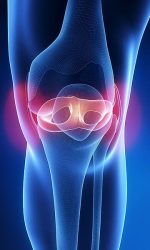Lateral Meniscus Tear

What is a meniscus tear?
The knee joint has two menisci or “shock absorbers” that are in place to prevent damage to the cartilage. They resist stresses in the knee joint and aid in preservation of the knee joints ability to provide painless motion and weight bearing. Occasionally, however, an injury may cause damage to these structures. Usually from a non-contact insult, but occasionally from a fracture, the menisci may be torn. Particularly, the lateral meniscus is commonly torn in the setting of an ACL tear. This causes pain, swelling and discomfort with walking and movement of the knee. You will occasionally feel a pop or catch that makes motion almost impossible. If severe, the knee may not move very much at all. Upon your initial evaluation, Dr. Davis will utilize some special exam tests to determine if the meniscus is injured. If so, xrays and an MRI scan will be needed to further determine the degree of damage.
Treatment
Treatment typically depends on multiple factors including additional injuries, age of the patient, chronicity of the tear, and more. If the injury is acute in a young patient, attempts will be made to perform an arthroscopic meniscus repair, utilizing suture and suture anchors to restore the meniscus’s ability to protect the knee joint. Occasionally, an acute tear may be so severe that repair is not possible. In these cases, meniscus removal, or a meniscectomy may be performed. Dr. Davis will do his best to avoid this result because accelerated joint degeneration will result. In young patients with non-reconstructible menisci, meniscus transplant may be an option. This however will have to be discussed at length to determine if you are a candidate. In the setting of chronic/degenerative tears in the older patient, repair is likely not indicated. Symptoms may include pain along with catching and popping. If the tear is associated with a high prevalence of pain, arthroscopic meniscal “clean up” will likely not be successful and the decision to move towards joint replacement may be discussed. All of this will be discussed at length in your visit with Dr. Davis.
Surgical Intervention
In most cases, meniscus injury can be addressed utilizing an arthroscope, with minimally invasive techniques. This involves identifying the character of the tear and utilizing suture anchors to restore its stability and function. Portions of the tear that are non-reconstructible will be removed utilizing a shaver and other instruments.
Post Op
Post-operatively, small dressings will be applied that may be removed postoperative day 3. Range of motion exercises may begin immediately and will be led by a physical therapist. Weight bearing will be limited to protect any tears that are repaired. However, weight bearing may resume immediately if the torn meniscus tissue is removed. For repairs, weight bearing will be gradually progressed at around the 4-6 week mark, with the goal of full weight bearing by 12 weeks post operatively. This timeline will be discussed during your postoperative course with direct oversight by Dr. Davis. Strengthening and range of motion therapy will be continued with a goal of returning to sport by the 4-6 month mark, depending on the patient. This will be discussed at length during the postoperative course.
